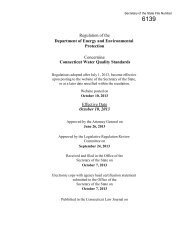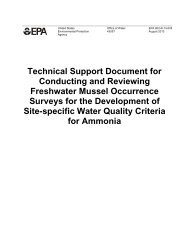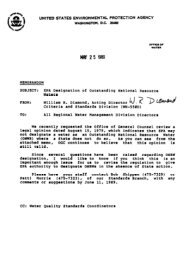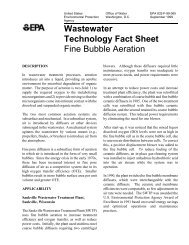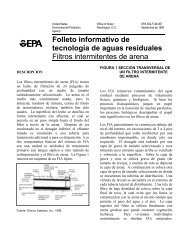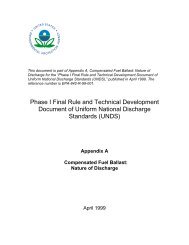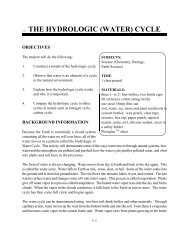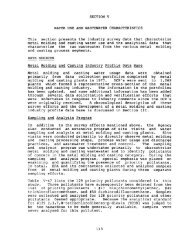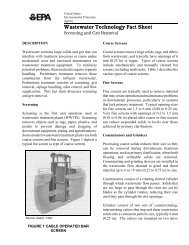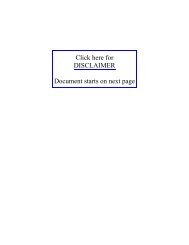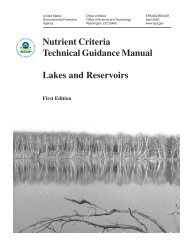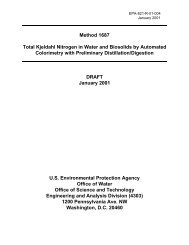Virginia Water Quality Standards - Water - US Environmental ...
Virginia Water Quality Standards - Water - US Environmental ...
Virginia Water Quality Standards - Water - US Environmental ...
Create successful ePaper yourself
Turn your PDF publications into a flip-book with our unique Google optimized e-Paper software.
9 VAC 25-260 - <strong>Virginia</strong> <strong>Water</strong> <strong>Quality</strong> <strong>Standards</strong><br />
January 2011<br />
about specific streams for permit writers and other interested persons. Trout waters classified as<br />
classes i or ii by the DGIF are also recognized in 9VAC25-260-110.<br />
DGIF STREAM CLASS DESCRIPTIONS.<br />
Wild natural trout streams.<br />
Class i. Stream of outstanding natural beauty possessing wilderness or at least remote<br />
characteristics, an abundance of large deep pools, and excellent fish cover. Substrate is<br />
variable with an abundance of coarse gravel and rubble. Stream contains a good population of<br />
wild trout or has the potential for such. Would be considered an exceptional wild trout stream.<br />
Class ii. Stream contains a good wild trout population or the potential for one but is lacking in<br />
aesthetic quality, productivity, and/or in some structural characteristic. Stream maintains good<br />
water quality and temperature, maintains at least a fair summer flow, and adjacent land is not<br />
extensively developed. Stream would be considered a good wild trout stream and would<br />
represent a major portion of <strong>Virginia</strong>'s wild trout waters.<br />
Class iii. Stream which contains a fair population of wild trout with carrying capacity depressed<br />
by natural factors or more commonly man-related landuse practices. Land use activities may<br />
result in heavy siltation of the stream, destruction of banks and fish cover, water quality<br />
degradation, increased water temperature, etc. Most streams would be considered to be in the<br />
active state of degradation or recovery from degradation. Alteration in landuse practices would<br />
generally improve carrying capacity of the stream.<br />
Class iv. Stream which contains an adequately reproducing wild trout population but has<br />
severely reduced summer flow characteristics. Fish are trapped in isolated pools where they are<br />
highly susceptible to predators and fishermen. Such streams could quickly be over-exploited<br />
and, therefore, provide difficult management problems.<br />
Stockable trout streams.<br />
Class v. Stream does not contain an adequately reproducing wild trout population nor does it<br />
have the potential for such. However, water quality is adequate, water temperature is good, and<br />
invertebrate productivity is exceptional. Pools are abundant with good size and depth and fish<br />
cover is excellent. Stream would be good for stocked trout but may offer more potential for a<br />
fingerling stocking program.<br />
Class vi. Stream does not contain a significant number of trout nor a significant population of<br />
warmwater gamefish. <strong>Water</strong> quality is adequate and water temperature good for summer<br />
carryover of stocked trout. Summer flow remains fair and adjacent land is not extensively<br />
developed. All streams in this class would be considered good trout stocking water.<br />
Class vii. Stream does not contain a significant number of trout nor a significant population of<br />
warmwater gamefish. <strong>Water</strong> quality and temperature are adequate for trout survival but<br />
productivity is marginal as are structural characteristics. Streams in this class could be included<br />
in a stocking program but they would be considered marginal and generally would not be<br />
recommended for stocking.<br />
Class viii. Stream does not contain a significant number of trout nor a significant population of<br />
warmwater gamefish. <strong>Water</strong> quality and temperature are adequate for trout but summer flows<br />
are very poor (less than 30% of channel). Streams in this class can provide good trout fishing<br />
during spring and early summer but would not be recommended for summer or fall stocking.<br />
Other. Remaining streams would be considered unsuitable for any type of trout fishery. Streams<br />
would be considered unsuitable under any of the following conditions:<br />
(a) summer temperatures unsuitable for trout survival;<br />
(b) stream contains a significant population of warmwater gamefish;<br />
(c) insufficient flow; or<br />
(d) intolerable water quality.<br />
65



